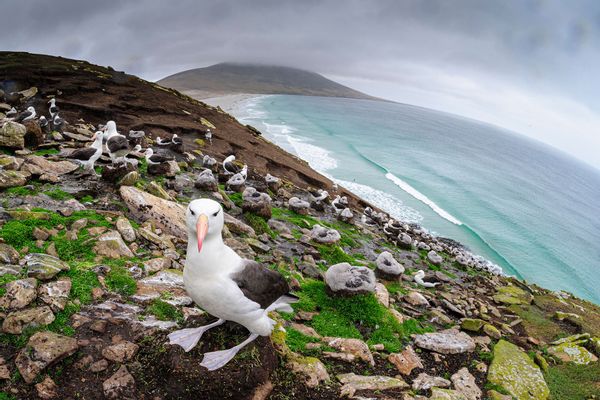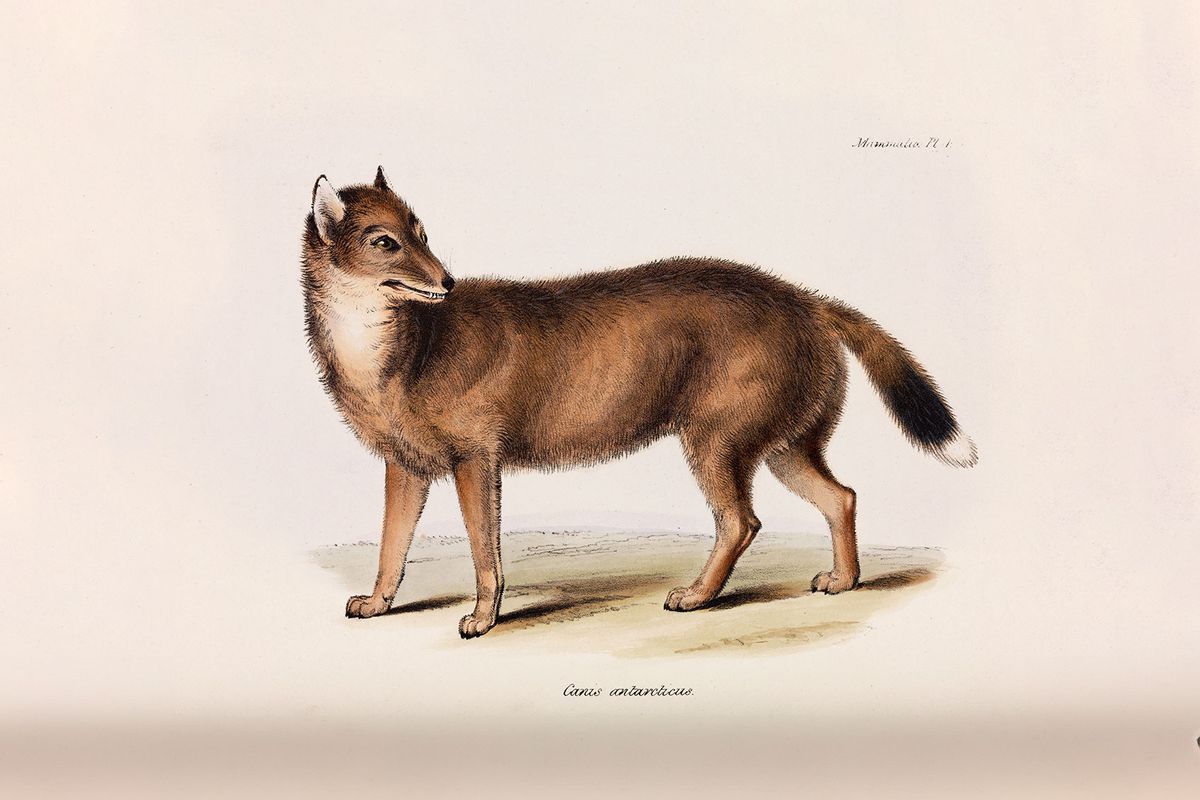From 1832 to1835, Darwin made his way through South America aboard HMS Beagle, during which time he made key observations pertaining to wildlife. Though Darwin’s exploits on the Galápagos are widely discussed, his travels in the South Atlantic, and specifically the Falkland Islands, are less well-known. Darwin traveled to the archipelago on two occasions, and his notes dealing with endemic flora and fauna hint at the naturalist’s later thinking on evolution.
One of the more curious aspects of Darwin’s trip to the Falklands relates to the warrah, a wolf-like creature and the sole terrestrial mammal inhabiting the isolated archipelago. How did the animal get to the islands in the first place, and could its presence in the Falklands hint at unexplored history?
I was eager to explore such questions recently, when I retraced Darwin’s travels in the South Atlantic. Flying to the Argentine coastal city of Puerto Madryn, I linked up with the Darwin 200 Initiative, a scientific expedition on the high seas. I then sailed aboard the tall Dutch ship Oosterschelde, as we made our way to isolated islands en route to Port Stanley. Unfortunately, the crew and I were not able to observe the warrah: the animal which had so intrigued Darwin went extinct due to overhunting in 1876, some forty years after the scientist had departed.
After laying anchor off Saunders Island, located northwest of West Falkland, my shipmates and I hiked to a sparsely populated settlement. There, I met David Pole-Evans, owner of the island. Today, he remarked, people don’t talk about the warrah, though he knows others who have come across warrah skulls. As to how the animals had wound up in the Falklands, Pole-Evans wasn’t sure, though he didn’t believe there had been Indigenous peoples living on the islands prior to European colonization.
"It is very curious thus having a quadruped peculiar to so small a tract of country."
Darwin himself was puzzled about how the warrah (Dusicyon australis), had arrived in the archipelago. Though the creature is sometimes referred to as the Falklands fox, the warrah did not physically resemble a fox or wolf, but rather a coyote or jackal. Could it have been transported to the islands, located less than 300 miles from mainland South America, or did the creature manage to travel on its own? Darwin speculated the creature might have arrived on icebergs.
“As far as I am aware,” he remarked, “there is no other instance in any part of the world, of so small a mass of broken land, distant from a continent, possessing so large a quadruped peculiar to itself.” Darwin wrote that locals had told him the warrah was native and endemic to the Falklands, which provided “indisputable proof of its individuality as a species: It is very curious thus having a quadruped peculiar to so small a tract of country.”
 Black-browed albatross (Thalassarche melanophris) in colony, Saunders Island, Falkland Islands (Getty Images/Image Broker/Michael Fischer)
Black-browed albatross (Thalassarche melanophris) in colony, Saunders Island, Falkland Islands (Getty Images/Image Broker/Michael Fischer)
On the surface at least, the warrah may seem like a mere footnote in Darwin’s travels, though the naturalist’s encounter with the creature would have far-reaching implications. Indeed, the warrah conundrum figured prominently in the development of Darwin’s ideas on evolution by natural selection.
The first time Darwin claimed species evolve and were not fixed entities was in reference to the warrah. The naturalist was impressed by reports of slight differences between the warrahs of East and West Falkland, noting the former was dark and the latter smaller and rusty-colored. Such findings suggest Darwin was starting to reflect on the development of animals in isolation and on islands. Later, the warrah provided Darwin’s only reference to the Falklands in “On the Origin of Species.”
Want more health and science stories in your inbox? Subscribe to Salon's weekly newsletter Lab Notes.
Perhaps the warrah’s trusting nature contributed to its untimely demise. Observing the creatures apparently had no fear, Darwin predicted that “within a very few years after these islands shall have become regularly settled, in all probability this fox will be classed with the dodo, as an animal which has perished from the face of the earth.”
After landing in Stanley and departing from the expedition, I headed to the Historic Dockyard Museum, whose holdings included an exhibit dealing with the warrah. Later, while touring around East Falkland, local guide Linda Buckland told me “Darwin always wrote the warrah was tame and you could get close to it. And very easy to kill and preserve.” Did the demise of the warrah provide a cautionary tale? Preserving wildlife is very important to locals, she said, and unfortunately, “the warrah was lost before we were ever born.”
What is the connection between the warrah and other South American canids?
Curious to learn more about the warrah’s mysterious origins, I caught up with experts over the following days. Archaeological evidence suggests Indigenous peoples of South America may have kept foxes as pets. Indeed, scientists have even discovered foxes buried in human graves from Patagonia, Argentina dating to 1,500 years ago.
After investigating bones, researchers determined the animal belonged to a species known as Dusicyon avus, which disappeared some 500 years ago, perhaps after being outcompeted for resources by more recent dogs. Reportedly, Dusicyon avus ate the same food as its human protectors, suggesting it was tame. Within Indigenous Yagán communities in Tierra del Fuego, foxes played an important role. Indeed, the extinct Fuegian dog, a domesticated form of the culpeo fox native to South America, participated in animal hunts.
What is the connection between the warrah and other South American canids? In 2009, scientists claimed to have cracked the case, asserting the warrah might have reached the Falklands after getting marooned on icebergs — just like Darwin had predicted. After analyzing DNA from museum specimens, including one collected by Darwin himself, researchers argued that humans could not have brought the creature across from South America since the specimens last shared a common ancestor dating to 70,000 years ago, long before homo sapiens arrived in the New World.
Other findings, however, challenge such views. Recent studies, in fact, suggest the case of the warrah has more far-reaching implications, since it touches on questions of Falklands identity and, potentially, pre-European Indigenous presence on the islands. Paul Brickle, a marine ecologist and CEO of SAERI (South Atlantic Environmental Research Institute), believes Indigenous peoples did in fact reach the Falklands long before Europeans arrived.
In an echo of archaeological sites in Patagonia, his team has uncovered evidence the warrah shared a similar diet to humans. Though the warrah is not related to the culpeo fox, its closest relative is Dusicyon avus, the most common canid in Fuego-Patagonian archaeological sites. Based on further genetic analysis, Brickle and his colleagues claim the warrah diverged from Dusicyon avus between 31,000 and 8,000 years ago. If such divergence occurred in South America, the warrah could have been brought to the Falklands by Indigenous Yagán or other peoples prior to European exploration of the South Atlantic. Darwin’s own observation that the warrah behaved in a docile and curious manner may bolster notions the creature was a semi-domesticated form of Dusicyon avus.
Sitting in the scientist’s office in Stanley, Brickle told me, “what is likely to have happened is people would have come across, survived for a couple of generations, and then died out.” He adds the Indigenous peoples would have come over in canoes. On New Island, the westernmost island in the archipelago, scientists have uncovered possible evidence of human settlement consistent with the mobile, sea-faring culture of the Yagán. More recently, Darwin reported seeing dugout canoes on Bleaker Island, in the south of East Falkland. Could the canoes have belonged to Indigenous people?
Emma Brook is a geologist and manager at Falklands College. “I do believe that Indigenous peoples from South America made it across,” she told me, though she would like to see more hard evidence. “The biggest problem,” she continued, “is that such people from Tierra del Fuego and Patagonia really lived symbiotically with the land, and they never really left much of a trace. I think if they did live here, they wouldn’t have been able to survive for very long, because the islands would have been too hostile for them to survive.”
We need your help to stay independent
If we can establish that Indigenous peoples made it to the Falklands, bringing the warrah with them in the process, how should we view the creature’s subsequent extinction at the hands of European settlers? In his own day, Darwin argued that extinction of species over time was simply the inevitable fate of those which could not compete. It goes without saying that such Victorian views are out of date, and society places a high premium on biodiversity and conservation.
And yet, should we view the warrah romantically, as a creature whose disappearance haunts the Falklands? In recent years, scientists have aimed to clone the Tasmanian tiger or thylacine, an extinct marsupial. If it were possible, should we seek the same for the warrah? “They were a non-native predator,” Brickle remarks, adding the creature could represent a threat to birds. In an ironic twist which makes me pause and reflect, the scientist declares “they should not have been here in the first place.”



Shares